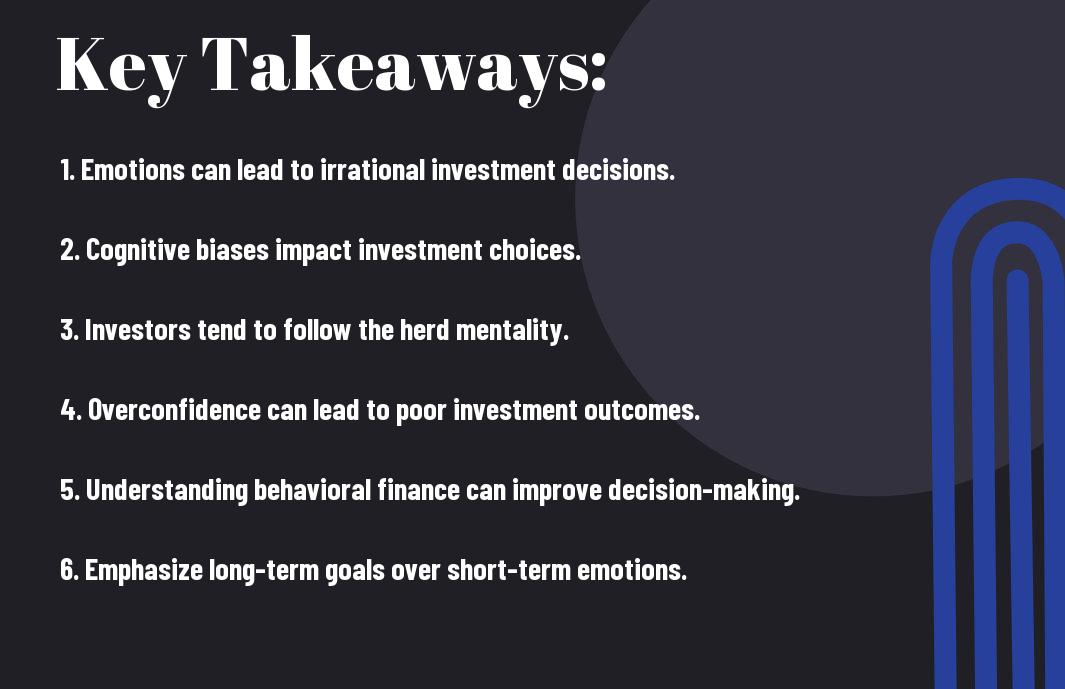There’s a fundamental aspect of investing that goes beyond just numbers and market trends – Behavioral Finance. This fascinating field explores how human emotions, biases, and psychological tendencies can impact financial decisions. Whether it’s the fear of missing out, overconfidence, or loss aversion, understanding these behavioral aspects is critical for investors hoping to make informed and successful investment choices. By recognizing and managing these behavioral biases, investors can enhance their decision-making process and optimize their investment outcomes in the long run.

Fundamental Concepts in Behavioral Finance
Heuristics and Biases
You may have heard about heuristics and biases in the context of behavioral finance. Biases refer to the systematic patterns of deviation from norm or rationality in judgment, whereas heuristics are mental shortcuts that individuals use to make decisions quickly. Some common biases include overconfidence, loss aversion, and anchoring, which can significantly impact investment decisions. Understanding these biases is crucial for investors to avoid making irrational choices based on flawed reasoning.
Prospect Theory
Fundamental to behavioral finance is Prospect Theory, developed by Daniel Kahneman and Amos Tversky. This theory suggests that individuals do not make decisions based on the final outcome alone but evaluate potential outcomes relative to a reference point. According to Prospect Theory, people are more sensitive to losses than gains of an equivalent amount, leading to risk-averse behavior when it comes to profits and risk-seeking behavior when facing losses.
Behavioral Finance and Its Impact on Investors
If you are interested in understanding the role of behavioral finance in investment decisions, you can explore more about it in Behavioral finance – The psychology behind investing. Behavioral finance plays a significant role in shaping the decisions and behaviors of investors, impacting their financial outcomes and investment strategies. By studying the psychological factors that influence investors, we can better understand how and why certain decisions are made in the financial markets.
Emotional Decision-Making
Investors are prone to making decisions based on emotions rather than rational analysis, leading to impulsive actions that can have detrimental effects on their investment portfolios. Emotions such as fear, greed, and over-excitement can cloud judgment and lead to poor decision-making, causing investors to buy or sell assets at the wrong time.
Overconfidence and Market Participation
Impact of overconfidence on market participation is significant, as it can lead investors to believe they have an edge over the market and take excessive risks. This overestimation of their abilities can result in higher trading frequency, increased investment in speculative assets, and ultimately, poor performance in the long run. Another consequence of overconfidence is reduced diversification in investment portfolios, which exposes investors to higher levels of risk.

Strategies for Mitigating Behavioral Biases
Importance of Diversification
To understand the importance of diversification in mitigating behavioral biases, one must acknowledge its role in reducing risk exposure. Diversifying investments across different asset classes and industries can help cushion the impact of market volatility and individual stock fluctuations. By spreading out investments, investors can protect their portfolios from the negative effects of concentrated positions or overexposure to a single sector. This strategy can help offset emotional decision-making influenced by biases such as overconfidence or loss aversion. For further insights on the impact of behavioral finance on investment decisions, refer to the Impact of Behavioral Finance/Economics on Investment Decisions.
Role of Financial Advisors
Role of Financial Advisors in managing and guiding investment decisions becomes crucial in mitigating the impact of behavioral biases. Financial advisors act as a voice of reason, providing objective analysis and guidance based on individual goals and risk tolerance. By bringing a rational perspective to the decision-making process, advisors can help prevent impulsive actions driven by emotions like fear or greed. Their expertise can aid investors in constructing well-balanced portfolios that align with their financial objectives and time horizon.
Final Words
Upon reflecting on the role of behavioral finance in investment decisions, it is evident that understanding human emotions and cognitive biases is crucial in making informed choices. Behavioral finance sheds light on how psychological factors influence investment decisions, often leading to suboptimal outcomes. By recognizing these tendencies and implementing strategies to mitigate their impact, investors can improve their decision-making process and enhance their overall portfolio performance. To probe deeper into the subject, check this insightful article on The Role of Behavioral Finance in Investment Decision Making.